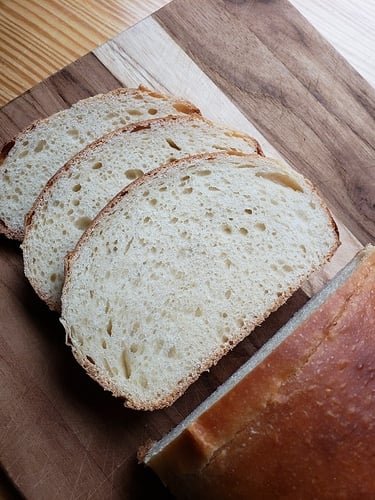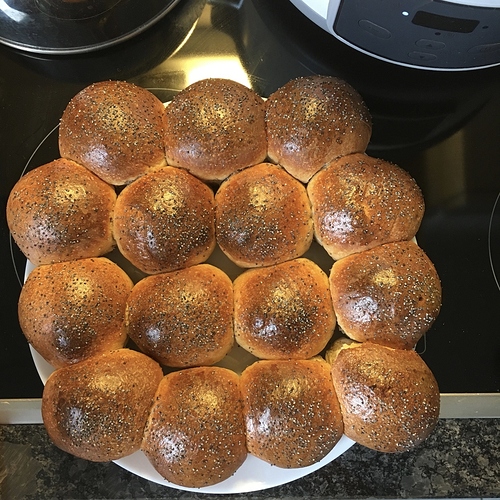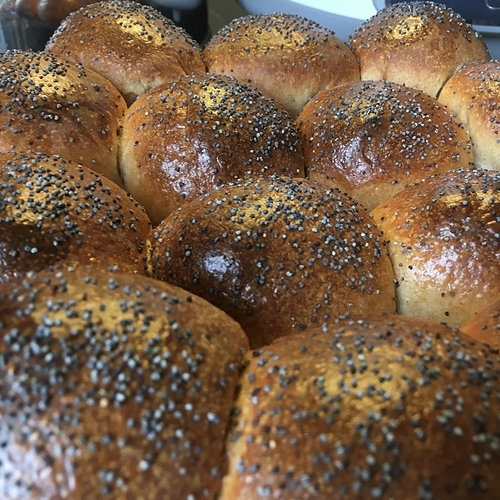Originally published at: http://breadtopia.com/hamburger-bun-recipe/
Bread baker and all around great guy, Joe Valencic, emailed me some photos of his no knead baking successes. In the loaves pictured, he mixed in a couple tablespoons of an Italian seasoning mix his cousin in Florida makes up. Upon inquiring further about this mix, Joe kindly sent some of the seasoning along for…
I usually only need 2 or 3 buns at a time. Could these be shaped and then frozen before the second proofing?
That should work. I think there’s a limit on how long you can freeze dough and still count on it rising again. I don’t know how long that is. Couple months maybe. Alternative is to bake then freeze but that takes more space in the freezer.
Hi, @eric.
Have you – or perhaps @Fermentada – tried a sourdough version of this recipe? I’ve been using another formula from a different source (“The Wild Yeast Blog”) for sourdough hamburger buns, but the results have been a bit disappointing.
The recipes here have been consistently good, so I’d love to hear about any experiments you have conducted with sourdough buns. Unless I’m missing something, there doesn’t seem to be a forum discussion about this issue.
All best
Phillip
What hasn’t been working for you with your current sourdough hamburger bun recipe? I don’t have experience making hamburger buns, but I do convert many recipes to sourdough, and I’m curious if your disappointment is the same one I have on occasion with enriched dough.
I often have trouble with the Maillard effect and I can’t figure out why this is the case with some recipes. I get a fluffy tasty sourdough crumb but the crust browns only a bit. I has something to do with sugar, lack of, of course. But why some recipes and how to remedy!
Anyhow…what are you having trouble with?
Thanks for your response.
In the recipe I’ve been playing with (see here), the result is a pretty decent bread, but not a good hamburger bun. The crust is consistently too firm for a hamburger, and it’s not as fluffy as it should be. I would even call it problematically dense, if we’re thinking within the category of “hamburger bun.” The buns brown nicely enough, but I want to achieve a softer crust and airier crumb.
Even though the recipe in the link only uses whole wheat flour, I’ve tried it with mostly white flour while maintaining the same overall ratios (I definitely want some whole wheat component). For example, this past weekend, I used 300g. white and 134g. whole wheat. The result was maybe an improvement, but still somewhat disappointing.
Judging by Breadtopia’s burger bun recipe, I wonder whether adding milk would help. But I’m not sure. If you’ve had good results with a sourdough variant, I’d love to try it.
I prefer a variant of this recipe https://breadtopia.com/soft-pull-apart-dinner-rolls. Made some all whole wheat hamburger buns yesterday (ok, about 5% was the white sd starter). Can’t tell you the exact measurements since, in typical fashion for me, I didn’t measure anything except the appropriate amount of salt and yeast. In addition to the starter which made up the poolish the night before, I added a bit of Bioreal yeast in the morning for some extra pop on the rise. The main thing I wanted to mention is that I used a lot of milk. Probably 2/3 of the liquid was milk. And a healthy dollop of butter. The buns were quite soft inside and out and because the hydration was highish, the crumb was pretty airy for whole grain.
Thanks! I’ll definitely try out this recipe as a starting point. I’d like to try leaving out the dry yeast and seeing how it goes with only the sourdough starter. I’m still a complete rookie with enriched dough, and I hope I don’t have to purchase yeast for getting the right kind of consistency.
Have you cold-proofed this dough before? After the rounds of stretch and fold, do you think it would do well in the fridge for, say, 18–24 hours?
I meant to ask earlier how you usually determine what needs to change when converting a recipe to sourdough. It’s something that I’ve wanted to do many times, but I haven’t felt like I’d know how to do it well.
Is it as simple as subtracting the dry yeast and then experimenting with an amount of starter? Or do you find that other measurements need to change too (e.g., water, salt, etc.)?
In the past, I’ve often made the yeast version first (cinnamon buns, soft rolls, hokkaido milk bread, bomboloni/donuts, challah). This gives me an idea of the intended dough hydration and feel, and the potential appearance the finished product. (I wouldn’t know I was missing brown color much earlier in the bake, if not for this lol.)
Then I make the recipe by adding sourdough starter instead of yeast, in a percentage usually greater than 15% of the flour weight. More than 15% seems like a safe bet to get fermentation going.
When I did a roll/brie cheese recipe for Breadtopia last December in yeast and sourdough versions, I reduced the flour and water by a tiny amount so the total dough weight would be the same and people could use the same weight for each roll. But usually, I just let the weight of the dough be a little higher (e.g. 80 g starter vs 7 g dry yeast)
I think I have also added a bit of extra flour in the past if the starter seems to make a low hydration dough feel wetter, but usually that’s not even necessary.
Here is the brie bread rolls recipe. In the photo gallery at the end, you can see that the sourdough version ferments differently. It doesn’t have a rounded top in the bowl. It also felt silkier and less rubbery. The rolls came out well though. I had to do two milk washes to get browning, but someone in the comments made the sourdough version and did not have the anemic Maillard reaction. (This leads me to think there is something particular about the character of my starter. It’s fascinating that starters are somewhat unique worlds. Some some people have really sour starters, which I don’t, but my starter is not good at dealing with fatty protein-ful doughs…or maybe it’s too efficient at eating the sugars in these doughs  )
)
The sourdough donuts that I made used a sweet stiff starter build, and I will be experimenting with that to see the impact on hokkaido milk bread. This one here was replacing yeast with 15% of my regular sourdough starter. It did get golden - but with three milk-egg washes.
Great, thanks! That seems really helpful for considering how to convert recipes into sourdough variants.
Yeah, I agree about starters being unique in interesting ways. Mine can sometimes produce a sour flavor, but it seems to happen consistently with particular combinations of flour – often involving wheat instead of, say, just rye or spelt. I’m not confident enough to say that the flour combination somehow fosters sourness, but it’s something I’ve noticed repeatedly. However, I intentionally keep the acid load in my starter pretty low (usually a 1:4:4 ratio for feedings), so that’s probably got something to do with a low degree of sourness in most of my loaves.
I’ll report back when I attempt a batch of the sourdough hamburger buns. My plan is to substitute honey for the sugar (in my experience, honey often allows good caramelization).
Those brie rolls sound really good, by the way!
I haven’t but I’m always a fan of prolonging the fermentation and cold proofing in the fridge can work. I would probably recommend trying first the easy way and the cold proof once you’re happy with the results you’re getting.
Okay, that sounds reasonable. I’ll certainly try it out. I made the mistake tonight of mentioning the idea of a fluffier bun to my 6-year old, so now there are definitely some entrenched expectations in the house…
Well, here’s the first attempt at converting the recipe to a sourdough version. Since the dough is appropriate for dinner rolls, as well as buns, I started with a batch of the dinner rolls. They tasted really good! I’ll probably raise the hydration a bit next time, since I’d like to get an even softer crumb if possible. But the crust and crumb were both nice and fluffy, as I had hoped.
These are 32% whole grain spelt, which I may also increase next time. Thank you @eric and @Fermentada for the very nice recipe and helpful tips. It’s a great starting point for thinking about how to make enriched dough.
I was a bit nervous during the bulk fermentation, since I didn’t know how long to let it go. I ended the bulk fermentation after about 6 hours, shaped the rolls (70g. apiece), and set them aside for a final proof of about 1.5 hours. 20 minutes of baking time seemed to do the trick.
I don’t own a pie tin, so I had to do my best at arranging them to mimic that kind of presentation.
Wow. I hope they taste as good as they look.
They look amazing. I’m curious to hear the verdict of your six-year-old 
Yeah, he was definitely a fan. Since I made them for dinner, though, he seems to have classified this dough as strictly for dinner and lunch – not breakfast. We had leftovers the next day, but he said it didn’t seem like breakfast bread…
Round 2 of the enriched sourdough recipe for hamburger buns was a success. The higher hydration really seems to have helped them not be as dense, and I may increase it more so next time, just to see what happens.
Instead of spelt this time, I used wheat. I’m not sure whether I have a preference at this point, since both were good.
My next goal is to try out a cool proof with this enriched dough. Does anyone know whether cold-proofing an enriched dough can have particular complications (e.g., with the butter)?
I don’t think I’ve seen negative effects from refrigerating an enriched dough - yeast or sourdough. Slow fermentation does become even slower, but that’s all I think I’ve noticed.
I believe Peter Reinhart’s brioche recipe specifically has you refrigerate before shaping to make the dough more manageable. That said, I’ve never gone longer than 24 hrs for donuts/challah/milk bread etc.
Beautiful rolls!
I’ve been making this recipe: Sourdough Burger Bun Plus shaped as hamburger buns, hotdog buns and sub rolls. It has some similarity to previous posts: milk and butter for the soft-fluffiness.
I’ve made it as written, then reduced sugar by half (I liked this better than original amount), and also a 1/2 white Kamut, 1/2 bread flour. All worked well. I’ve frozen baked buns and they thaw and warm wonderfully. I’ve also frozen the dough in bun amount but no shaping, thawed, shaped and baked - that worked very well also. To date, after trying many recipes, this is my FAVORITE bun and sandwich roll recipe. I do think the original is a bit sweet, but that’s me and easy to reduce the sugar. The directions in the linked post and the photos make it easy.




